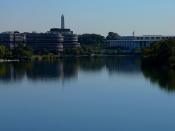Opposition to the Federal party began in 1790, when Hamilton broached a project for the assumption of State debts by the central government. It grew stronger in 1791, when he proposed to establish a national bank. Jefferson, who had been the first Secretary of State, was now found at the head of a party in open opposition to the administration. This party, though adopting the name of Republicans, advocated the principles of the older Anti-Federalists, claiming that there was a scheme to subvert the State governments and establish a strong central government, and denouncing the Hamilton party as monarchists. Democratic clubs soon after arose, instigated by, and imitating many of the follies of, the Jacobin revolutionists of France. They had the one good effect of introducing political discussion among the masses of the people, and in a few years the Democrats coalesced with the Republicans as a single national party.
The Federalists, however, continued in the majority, and in 1792 Washington and Adams were again elected President and Vice-President. During this second term the power of the Republican party rapidly increased. The acts of the administration were fiercely attacked, and when, at the approach of a new election, Washington announced his intention to retire, a hot political contest arose, which nearly resulted in a Republican victory. Of the electoral votes Adams received seventy-one, and Jefferson sixty-eight, the latter receiving all but two of the Southern votes. The new administration was therefore organized with Adams for President and Jefferson for Vice-President. The financial condition of the country had now greatly improved. A sound credit was established, funds were provided for the payment of the national debt, and treaties were concluded with the Indians and with several of the European powers, while a very rapid increase in population and in agricultural and...


